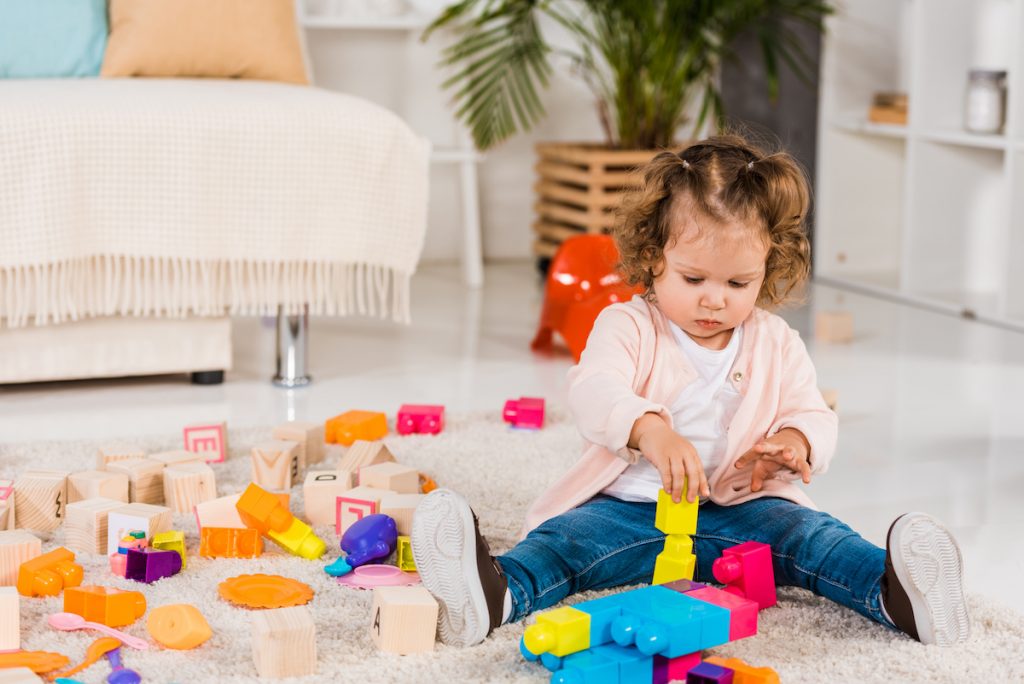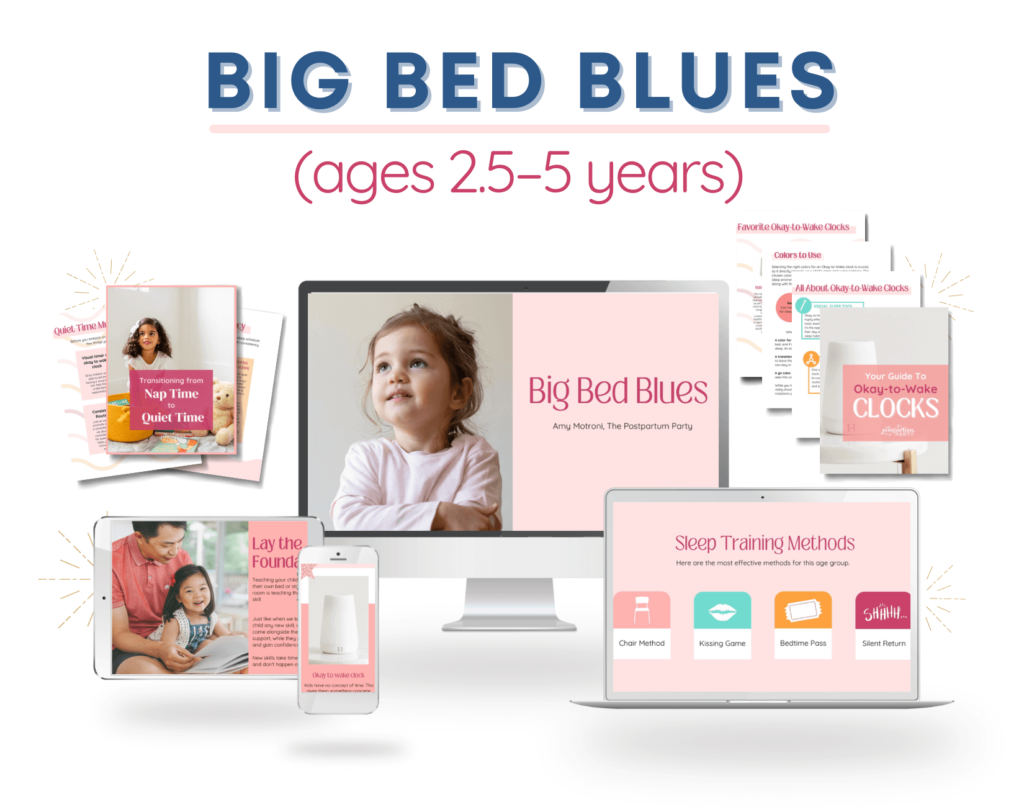Learn how to introduce quiet time for kids. Get our best quiet time tips as well as ideas for activities you can include in your child’s quiet time.

This post and the photos within it may contain Amazon or other affiliate links. If you purchase something through the link, I may receive a small commission at no extra charge to you.
If your child is showing you the signs that they’re ready to drop the nap, you can make the transition from nap time to quiet time and keep everyone’s midday break in tact.
What Is Daily Quiet Time for Kids?
Quiet time for kids is a midday break, where your child plays quietly in their room, in place of nap time.
Is Quiet Time Good for Kids?
Quiet time is great for kids, as it allows them to have some quiet independent play time, which fosters creativity, problem-solving, and self-regulation.
Quiet time also gives your child a break from outside stimulation, screens, and siblings and allows them to reset through play.
Parents also look forward to quiet time, as we can use the time to rest, read, or be productive.
When to Start Quiet Time
When your child is ready to drop their nap, you can introduce quiet time as an alternative.
Kids stop napping between ages 2 and 5.
If that’s your child, I’ve found the best time to introduce quiet time is immediately when kids no longer nap. It makes the transition much easier, than trying to add quiet time into an already no-nap schedule.
If your little one completely drops the nap and starts filling that time with something else (gymnastics class, playground time, etc.), it can be trickier to help them re-program into a quiet time routine.
What Do You Do in Quiet Time?
Keep in mind that quiet times may look a little different depending on how old your child is.
Quiet time for toddlers will be different than quiet time for older kids.
For example, my daughter’s quiet time is filled with lots of stuffed animals. I almost always hear her in there talking to each of them, setting up a birthday party or preschool program.
Some kids are happy with lots of books and others may need something more exciting.
You’ll need to swap out activities based on your child’s interests and developmental milestones.
Here are some quiet time toys and activities we love:
- Books, especially series like Tony Mitton’s transportation books (be sure to rotate regularly)
- Magna Tiles
- Little People sets
- Figurines from favorite TV shows and movies
- Simple puzzles
- Triangle grip crayons and coloring books (only if you trust your child to not color on the walls!)
- Dolls and doll accessories
- Magnetic Tins
- Reusable sticker pads and stickers
- Quiet books
Make sure your child knows where to find their favorites, but switch things up every so often to keep the space engaging as well.
Try to keep loud, high-energy toys out of reach to encourage the relaxing atmosphere.
Make sure that you are within earshot of your child’s room, or that you have a visual/audio monitor nearby during quiet time.
While the goal is for this to be a calm and soothing time, remember that your child is still awake and active.
For safety purposes, they should not be completely unattended and left fully to their own devices. It’s best to check in periodically, even by peeking at the monitor or listening at the door.
How Long Should Quiet Time be for Kids?
Most children will do well with a daily 1–2 hour quiet time.
Some children play independently better than others and can make it the full 2 hours.
Tips for A Successful Quiet Time with Kids and Toddlers
If your child resists quiet time, you’re not alone!
We had to work really hard to make quiet time work in our family, but now my 6 year old does an hour almost daily.
Here are some tips to having a successful quiet time with your kids.
1. Prepare your Child for Quiet Time
Kids find it so helpful when we prepare them for what’s coming. Tell your child you notice that he isn’t falling asleep during nap time.
Ask him if he’d like to read and play quietly in his room instead of taking a nap. The answer is almost always an emphatic, “YES!”
2. Keep your Pre-Nap Routine
If you have any sort of nap routine or rituals before going down for a nap, keep doing them as you introduce quiet time. This will help prepare your child for the transition and make it feel seamless.
We always read 2 books before nap time and then do a quick snuggle.
Whatever you’ve been doing for your nap time routine, you can continue to do it leading up to quiet time as well.
3. Set Expectations
In working with families for sleep, I always find that the families who are the most successful are the one who are very clear with the boundaries and expectations for their children.
Remind them that if they feel rested, they can get out of bed and play quietly in their room instead of taking a nap.
Let them know you will also be doing a quiet time.
You can let them know to come find you if they need something, but otherwise they are expected to play in their room until quiet time ends.
These conversations may be easier or harder depending on your child’s age and personality.
4. Start Small
If your child is just starting with quiet time, set them up for success by starting with a short quiet time and slowly adding on.
Start with just 10 to 15 minutes and give your child lots of positive reinforcement if they stayed in their space the whole time.
You can gradually increase the time each day until your child has worked their way up to about 60–120 minutes.
When we first started, quiet time was new and strange to our daughter, and it felt shorter than I’d like.
The first day we started quiet time, she was able to play quietly for about 20 minutes. Now that she’s more familiar with the routine, her quiet time usually lasts about 1 hour.
5. Use an Okay to Wake Clock
Kids don’t have a concept of time so it’s helpful to provide them with visual aids.
Use a visual timer or okay to wake clock such as the Hatch Rest to show your child when it’s quiet time and when it will be over.
6. Implement a Reward System
When kids are learning a new skill it’s helpful to incentivize them.
You can implement a reward system to help encourage your child to stay in his room during quiet time.
We used to watch TV each morning, but switched our screen time to after quiet time so that it was an incentive for completing quiet time successfully.
I give my daughter three chances to come out to ask me for something during quiet time. After 3 times I remind her that if she comes out a 4th time, we won’t be able to watch TV today.
She is free to come out to use the bathroom at any time (but we also usually go potty before we start quiet time).
Guess what? She usually comes out three times and that’s it! They will push their limits to about as much as you allow them.
Make sure you follow up on what you say. If you never actually take screen time away, well they’re never going to stick with quiet time. It usually just takes one time for it to stick!
7. Prepare the Room
Instead of turning out the lights like you would for a nap, consider dimming them. This keeps the atmosphere calm and cozy but safely allows for some movement and play.
We keep a basket of special toys that my daughter only gets for quiet time so that they have the novelty effect.
It may sound counterintuitive, but I’ve also found it helpful not to have too many toys out at once.
I make the quiet time space feel calm by quickly tidying up so my daughter doesn’t get overwhelmed by options.
If your Child Resists Quiet Time
Be patient and consistent if your toddler refuses quiet time. It may take him a longer time to build up to a nap-length quiet time, but it can be done.
If your child is fighting quiet time or continues to get out of his room, you may need to start with less time on the clock.
It might help reassure your toddler if you peek your head into his room every so often. You can use this check-in time to help guide him to another quiet time activity if he’s lost focus.
As he learns to jump from one activity to the next with your help, he’ll eventually be able to do it independently.
If your child hasn’t mastered independent play yet, practice some quiet time activities with him at other times during the day.
Once he learns how to do these things with you, he’ll be better equipped to do them on his own.
At your wit’s end with your child getting out of bed?
The Big Bed Blues course walks you through the process of getting your child to sleep in their own bed for 10–12 hours every night. End the power struggles and sleepless nights once and for all with the Big Bed Blues Course.
Is Quiet Time As Good as a Nap?
This depends on if your child still needs a nap. Most kids still need a nap up until about age 3 or 4.
If your toddler is skipping nap time and you’re thinking about introducing quiet time, wait!
In that case, quiet time will not be as good as a nap and you’ll end up with a toddler whose melting down at 5 pm (Trust me, I’ve been there!).
If your child is 3 or older and isn’t melting down every evening without a nap, then quiet time is a great alternative! By that age, kids don’t need a nap as much or at all.
Quiet time for kids can be enough to get a little rest and reset to make it through the day! You can see an optimal three year old schedule here.
Why Is Quiet Time Important for Children?
Your child’s body may not need a nap to physically recharge anymore, but their brains are working harder than ever.
Quiet time allows for a safe, low-stimulation environment for them to engage their imaginations and creativity without interruption.
Quiet time is an excellent way for your toddler to build skills in independence.
It allows them to practice autonomy (what should I do next?) and problem solving (how do I get this to work?).
The skills they learn in self-directed play can carry over into other parts of their day!
Unstructured play for children is so important for their creativity and independence. If they’re always around an adult who is structuring their activities, it’s harder for them to develop autonomy.
Quiet time is a scheduled part of their routine that removes adults from the play equation.
Finally, rest allows for renewal. I have had many days with my daughter that were headed in the wrong direction, and we both needed a reset.
Quiet time has become our reset button, and has turned so many days around for the both of us. I hope you find it just as helpful!
Ready to say goodbye to sleepless nights?
We have a sleep solution for all ages. From newborn–preschoolers, we believe the whole family thrives when everyone is well-rested.
Select your child’s age to get started:
- Practical Tips if your Toddler is Going Through A 3-Year Old Sleep Regression - April 26, 2024
- Baby Led Weaning vs Purees — Which Should I Choose? - April 25, 2024
- 10 Adorable Letter Board Pregnancy Announcements - April 25, 2024











